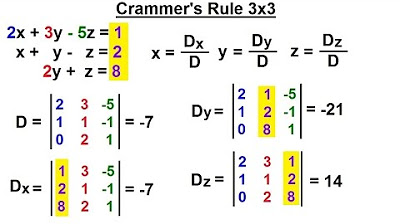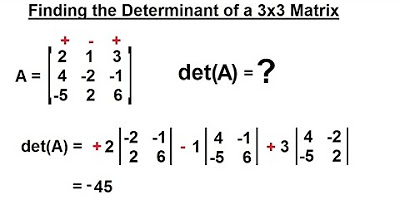Cramer's Rule - 2x2 & 3x3 Matrices - Solving Systems of Linear Equations - 2 & 3 Variables
TLDRThis video script offers a comprehensive guide on applying Kramer's Rule to solve systems of linear equations with two and three variables. The process involves calculating determinants to find the values of x, y, and z for the given equations. The script provides step-by-step instructions, including setting up matrices, calculating determinants for 2x2 and 3x3 systems, and verifying the solutions. It emphasizes the importance of accuracy and patience in this method, suggesting practice for proficiency.
Takeaways
- 📚 Kramer's Rule is a method used to solve systems of linear equations with multiple variables.
- 🔢 For a two-variable system, the value of x and y can be calculated using determinants.
- 🎯 The determinant of a 2x2 matrix (d) is found by multiplying the diagonal elements and subtracting the product of the off-diagonal elements.
- 📐 To find dx and dy, replace the coefficients of x and y in the matrix with the constants from the equations and calculate the determinants.
- 🌟 The values of x and y are found by dividing dx and dy by the determinant d.
- 📈 The script provides an example of solving a two-variable system using Kramer's Rule, resulting in the solution (x=2, y=3).
- 🔑 Kramer's Rule can also be applied to systems with three variables, involving a 3x3 matrix.
- 📊 For a three-variable system, the determinant d and the determinants for dx, dy, and dz are calculated using a similar process but with more complex matrices.
- 🌐 The script includes an example of solving a three-variable system, resulting in the solution (x=1, y=2, z=3).
- 🛠️ Kramer's Rule is a method that requires patience and careful calculations, as one mistake can invalidate the entire solution.
- 📖 Practice is essential to master Kramer's Rule and apply it efficiently to solve various systems of equations.
Q & A
What is Kramer's Rule and how is it used?
-Kramer's Rule is a method used to solve systems of linear equations with multiple variables. It is particularly useful for systems with two or three variables. The rule involves calculating the determinant of matrices formed by the coefficients of the variables and then using these determinants to find the values of the variables.
How do you calculate the determinant of a 2x2 matrix?
-The determinant of a 2x2 matrix is calculated by multiplying the diagonal elements and then subtracting the product of the off-diagonal elements. For a matrix [a1, b1; b2, a2], the determinant d is given by d = a1*a2 - b1*b2.
What are dx, dy, and the determinant d in the context of Kramer's Rule?
-In Kramer's Rule, dx, dy, and d are determinants used to find the solution of a system of linear equations. dx and dy are the determinants formed by replacing the coefficients of x and y in the original matrix with the constants from the equations. The determinant d is the determinant of the original matrix formed by the coefficients of the variables.
How do you find the values of x and y using Kramer's Rule?
-Once you have calculated the determinants dx, dy, and d, you can find the values of x and y by dividing dx and dy by d. The values are given by x = dx/d and y = dy/d. If the determinant d is zero, the system may be dependent or inconsistent, and a unique solution may not exist.
What is the process for solving a system of equations with three variables using Kramer's Rule?
-To solve a system with three variables using Kramer's Rule, you first calculate the determinant d of the 3x3 matrix formed by the coefficients of the variables. Then, you calculate the determinants dx, dy, and dz by replacing the coefficients of x, y, and z with the constants from the equations, respectively. The values of the variables x, y, and z are then found by dividing the corresponding determinants by d (x = dx/d, y = dy/d, z = dz/d).
How do you verify the solution of a system of equations?
-To verify the solution, you plug the calculated values of the variables back into the original equations and check if both sides of each equation are equal. If they are, then the solution is correct.
What are some alternative methods to Kramer's Rule for solving systems of linear equations?
-Alternative methods to Kramer's Rule include the substitution method and the elimination method. These methods can be simpler and quicker to use, especially for smaller systems of equations.
Why might a teacher require the use of Kramer's Rule over other methods?
-A teacher might require the use of Kramer's Rule to ensure that students understand the concept of determinants and how they can be applied to solve systems of linear equations. It also provides practice in handling more complex systems with multiple variables.
What is the significance of the determinant d being zero in the context of the system of equations?
-If the determinant d is zero, it suggests that the system of equations may not have a unique solution. The system could be dependent (infinitely many solutions) or inconsistent (no solution). Further analysis is needed to determine the nature of the system.
How does the process of calculating the determinant for a 3x3 matrix differ from that of a 2x2 matrix?
-Calculating the determinant for a 3x3 matrix is more complex than for a 2x2 matrix. For a 3x3 matrix, you break down the larger matrix into three smaller 2x2 matrices, calculate their determinants, and then combine these results following a specific pattern that involves adding and subtracting the products of the elements along the main diagonals.
What are the steps involved in calculating the determinant of a 3x3 matrix?
-To calculate the determinant of a 3x3 matrix, you first eliminate one row and one column from the matrix, then calculate the determinants of the three resulting 2x2 matrices. You then combine these determinants by multiplying the elements of the eliminated row and column by the determinants of the 2x2 matrices and summing them up according to the pattern of addition and subtraction along the main diagonals.
How does Kramer's Rule help in understanding the relationship between the coefficients and constants in a system of equations?
-Kramer's Rule emphasizes the relationship between the coefficients of the variables and the constants in a system of equations by requiring you to form matrices with these elements. The process of calculating the determinants dx, dy, dz, and d highlights how these elements interact to produce the solution to the system, enhancing the understanding of the underlying structure of the equations.
Outlines
📚 Introduction to Kramer's Rule
This paragraph introduces Kramer's Rule, a method for solving systems of linear equations with multiple variables. It explains the basic concept of applying the rule to systems with two and three variables, and sets up the foundation for understanding how to calculate the determinant of a matrix, which is crucial for this method. The paragraph outlines the process of finding the values of x and y in a two-variable system using determinants.
🧮 Calculation of Determinants and Coefficients
This paragraph delves into the specifics of calculating determinants for 2x2 matrices and how they are used to find the coefficients dx, dy, and d. It provides a step-by-step walkthrough of the process, including replacing coefficients with constants from the equations and computing the determinant to find the values of x and y. The paragraph also presents an example to illustrate the calculation, reinforcing the method with practical application.
🔢 Application of Kramer's Rule to a Two-Variable System
This paragraph demonstrates the application of Kramer's Rule to a practical example involving a two-variable system. It shows how to calculate the determinant (d), dx, and dy using the coefficients from the given equations. The paragraph then uses these values to solve for x and y, verifying the solution by plugging the values back into the original equations. This example serves to clarify the process and validate the method for solving systems of equations.
📈 Extending Kramer's Rule to Three-Variable Systems
The paragraph discusses the extension of Kramer's Rule to systems involving three variables. It explains the setup for calculating the determinant (d) for a 3x3 matrix and how to find the coefficients dx, dy, and dz. The explanation includes the process of replacing the coefficients of each variable with the constants from the equations and setting up the appropriate matrices for calculation. This section lays the groundwork for solving more complex systems involving three variables.
📊 Detailed Calculation for a Three-Variable System
This paragraph provides a detailed example of applying Kramer's Rule to a three-variable system. It outlines the steps for calculating the determinant (d), dx, dy, and dz for the given system of equations. The paragraph breaks down the process of eliminating variables and calculating the determinants for the smaller 2x2 matrices, leading to the final values for x, y, and z. The comprehensive explanation ensures a clear understanding of the method for solving three-variable systems.
🎓 Verification of the Solution
The paragraph concludes the application of Kramer's Rule by verifying the calculated values of x, y, and z. It demonstrates how to plug these values back into the original equations to ensure they satisfy all three equations in the system. The verification process confirms the accuracy of the solution and reinforces the reliability of Kramer's Rule for solving systems of linear equations with multiple variables.
Mindmap
Keywords
💡Kramer's Rule
💡System of Equations
💡Determinant
💡Two-Variable System
💡Three-Variable System
💡Matrix
💡Coefficients
💡Variables
💡Equilibrium
💡Substitution Method
💡Elimination Method
Highlights
Introduction to Kramer's Rule for solving systems of equations with two and three variables.
Explanation of how to calculate the value of x and y using a two-variable system.
Method for finding the determinant of a two by two matrix using the formula a1*b2 - a2*b1.
Procedure for calculating dx and dy by replacing the coefficients of x and y with the constants from the equations.
Illustration of how to apply Kramer's Rule through the solution of a practical two-variable system example.
Verification of the solution by plugging the values of x and y back into the original equations.
Introduction to the application of Kramer's Rule for a three-variable system.
Explanation of setting up the determinant for a three by three matrix with coefficients of x, y, and z.
Breakdown of how to calculate the determinant of a three by three matrix using smaller two by two matrices.
Example of solving a three-variable system by finding d, dx, dy, and dz, and the method for checking the solution.
Discussion on the practicality and patience required when using Kramer's Rule as opposed to other methods like substitution or elimination.
Emphasis on the importance of accuracy and attention to detail when performing the calculations in Kramer's Rule.
Encouragement for practice and mastery of Kramer's Rule for educational purposes, despite the availability of other solving techniques.
Transcripts
Browse More Related Video

Cramer's Rule - 3x3 Linear System

Cramer's Rule - 2x2 Linear System

Cramer's Rule Explained

PreCalculus - Matrices & Matrix Applications (33 of 33) Using Cramer's Rule to Find x=? y=? z=?

PreCalculus - Matrices & Matrix Applications (30 of 33) Find the Determinant of a 3x3 Matrix 1

7.1.1 Solving a System of Equations Using Substitution
5.0 / 5 (0 votes)
Thanks for rating: